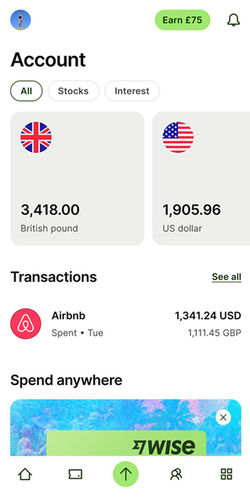The best, fastest & cheapest ways to send money to United States
Compare money transfer services and find the cheapest and easiest ways to make money transfers to United States.
Learn how to secure the best USD exchange rates at the lowest transfer fees, ensuring a smooth and easy transfer process.
If you just need the best service for USD transfers, it is Wise. Out of 2 companies tested that support USD, they appeared 100% of the time as the top-rated provider in our comparisons.
Otherwise, keep reading for expert tips, top USD transfer deals, and everything you need to know about transferring money to United States.
Send money to United States
"Over 16 million customers use Wise, mostly for their excellent mobile app, transparent fee structure & use of mid-market rates. Now increasingly used for larger transfers."
"Over 16 million customers use Wise, mostly for their excellent mobile app, transparent fee structure & use of mid-market rates. Now increasingly used for larger transfers."
"Over 16 million customers use Wise, mostly for their excellent mobile app, transparent fee structure & use of mid-market rates. Now increasingly used for larger transfers."
"Over 16 million customers use Wise, mostly for their excellent mobile app, transparent fee structure & use of mid-market rates. Now increasingly used for larger transfers."
"Over 16 million customers use Wise, mostly for their excellent mobile app, transparent fee structure & use of mid-market rates. Now increasingly used for larger transfers."
"Over 16 million customers use Wise, mostly for their excellent mobile app, transparent fee structure & use of mid-market rates. Now increasingly used for larger transfers."
"Remitly focuses on sending money to friends and family in Asia, Africa and South America. Wide coverage and well-suited to regular transfers home."
"Remitly focuses on sending money to friends and family in Asia, Africa and South America. Wide coverage and well-suited to regular transfers home."
"Remitly focuses on sending money to friends and family in Asia, Africa and South America. Wide coverage and well-suited to regular transfers home."
How to get the best rate when sending money to United States
Always compare rates
Don't pay more than you have to. Use our live comparison tool to make sure you aren't missing the best rates on USD transfers.
Choose a provider
Select the provider that offers you the most USD and fits your transfer needs.
Click, sign up & send
Follow the steps & make your transfer. Your transfer to United States will soon be on its way.
Transfer limits on money transfers to the US
Any transfers over $10,000 are automatically reported to the IRS as part of AML.
Some money transfer services will put limits in place and adjust their rates accordingly. Typically, FX brokers and managed services will offer better rates for larger transfers.
Considering this, here are a few examples of transfers by amount.
Overall best choice: Wise
We tested & reviewed 2 companies offering transfers to United States, and Wise scored the highest.
Wise offers the best combination of transfer fees, rates, speed, and has the best overall experience for transfers to US.
At the moment, if you were to send $7,000 to USD, it would cost you $9.03 in fees, and your recipient will get 6,990.97 USD.

Remitly is the cheapest way to send money to United States
Remitly charges $0 per transfer and adds a 0% markup on top of the US Dollar exchange rate.
bank transfer is the cheapest funding option when sending money to United States. Pair it together with Remitly, to get the most out of your USD transfer.

The fastest way to send money to United States: Wise
Based on a $7,000 transfer and our comparison data for USD transfers, Wise is the quickest option for sending USD to United States.
With Wise, the transfer time to United States is next day.
They charge $9.03 in fees and apply a 0% markup on the ‘real’ USD rate. This is 0% cheaper than the second-best provider.
For the best balance between speed and cost, we suggest using a deposit for US Dollar transfers.

The easiest way to send money to United States: Wise
They’re highly transparent with fees, charging $9.03 per transfer with a 0% markup on the USD mid-market rate.
With multiple deposit and withdrawal options and reliable customer service, getting started with Wise takes less than 10 minutes, making it a fast, cheap, and user-friendly option.

Consider this before sending money to United States
Don't settle for the first option. Always compare ways to send money to United States to find out about fees, speed, and reliability.
Our analysis included 2 providers that operate in United States.
Through this, you get a comprehensive view of all the options you have when sending money to United States.
Sending large amounts of USD to United States
Remitly consistently ranked as the top choice for large USD transfers. They charge $0 per transfer to United States and apply only a 0% markup on the USD exchange rate.
Whether you’re purchasing property, paying tuition fees in USD, planning a wedding in United States, or making business payments, Remitly ensures a smooth and secure process.
When sending large amounts of US Dollar to United States, consider factors like transfer limits, markup on the USD rate, customer service, and any legal, tax, or government-imposed restrictions in United States.

Understand the costs of money transfers to United States
The total cost of USD transfers depends on your location, the amount of USD sent, the delivery/deposit methods, transfer fees, and the markup applied to the USD exchange rate.
Transfer fee
The money transfer service you use to send US Dollar can apply a fixed fee, a percentage-based fee, or a combination of both.
For example, a $7,000 transfer to United States will cost you $0 in fees with Remitly, based on our December 2025 analysis of 2 services supporting US Dollar transfers.
USD exchange rate markup
An exchange rate markup is the percentage added to the mid-market USD rate.
Using the same example, Remitly offers the best USD exchange rates, with a 0% markup on the USD-USD rate. This means for every USD sent, you receive 1 USD with 0% deducted from it.
Deposit method
How you fund your transfer can significantly impact the overall cost.
Bank transfer is the most common option, costing up to $9.03 per transfer to United States.
Debit card transfers can go as high as $0 in fees, while credit cards are usually more expensive and may include additional cash advance fees.
bank transfer is the cheapest payment method for sending USD.

How to get the best USD exchange rate for money transfers to the US
The exchange rate is the value of the USD (US Dollar) against other currencies, and since it fluctuates consistently, it will affect how much USD the recipient will get. Sending money when the US Dollar reaches its highest value against your home currency will result in more USD for your recipient.
Let's dive into some trends of USD-EUR over the past 7 days:
The US dollar averaged at 1.1744 USD per EUR
Reached a high of 1.1801 USD /EUR
Dropped to a low of 1.1712 USD per Euro
You should aim to send money when the rate is closer to 1.1801 USD per Euro. This will get your recipient more USD.
Pair your transfer with Wise (who offers the best exchange rate), and you will maximize the amount of USD received.
Want to secure the best US Dollar exchange rates?
Sign up for our rate alerts and we'll tell you when it's the best time to move your money to United States!
Payment methods available for money transfers to United States
How you fund your money transfer to United States directly affects the speed, cost, and the amount of USD your recipient will receive. Here are the most common options for funding your transfer to United States:
Bank transfers
Bank deposits are reliable and common for international USD transfers, available through most services.
While they tend to be cheaper, it may take up to 2-3 business days for the funds to arrive.
You also may have an option to use the SWIFT network for a bank deposit to United States, avoid it where possible. SWIFT deposits are slow and expensive, instead check if there are cheaper options.
Based on our recent testing of 2 providers accepting United States transfers, we found Remitly to be the cheapest option, charging $0 per transfer with a 0% markup.

Debit and prepaid cards
Debit card transfers to United States are generally faster than bank transfers. Most USD transactions will be completed within a few hours. However, this convenience usually comes with increased fees.
We recommend Remitly for debit and prepaid card deposits when sending money to United States. Remitly charges a 0% markup on the USD rate and $0 in transfer fees.

Credit cards
A credit card deposit is another option for sending USD to United States.
Typically it is more expensive, and your CC company may charge you cash advance fees, and apply increased interest rates.
If you want to fund your transfer to United States with a credit card, we to get the best deal.

How we analyze the market
We track the cost, speed, and product offerings of the leading money transfer services available in United States.
Our comparison engine and algorithms evaluate providers based on over 25 factors, including transfer fees, ease of use, exchange rates, mobile apps, transfer times & customer support.
We also consider how these services are rated on platforms like TrustPilot, AppStore, and Google Play, giving you a comprehensive view of what to expect.
This thorough analysis helps you get the best available deal - every time you want to move money to United States.
We also provide unbiased and detailed reviews of all the top money transfer companies. You can use these reviews to find the best service for your needs when sending money to United States
For a deeper understanding of our commitment to integrity and transparency, we invite you to read our editorial policy and review methodology.

Related transfer routes
Send money from United States
Send money to United States
FAQs
Find answers to the most common questions on our dedicated FAQ page.
How much money can be transferred to United States?
Are there any tax implications to sending money to United States?
What are the typical transfer fees for sending money to United States?
How long does it take to send money to United States?
Are there any minimum or maximum transfer limits for transfers to United States?
Can I schedule regular transfers to United States?
What currency is used in United States?
Can I send money to United States from any country?
How can I track my money transfer to United States?
What should I do if my money transfer to United States goes wrong?
Can’t I use my bank to send money to United States?
Why send money to the US?
Can I send money to United States with MoneyTransfers.com?
Contributors








